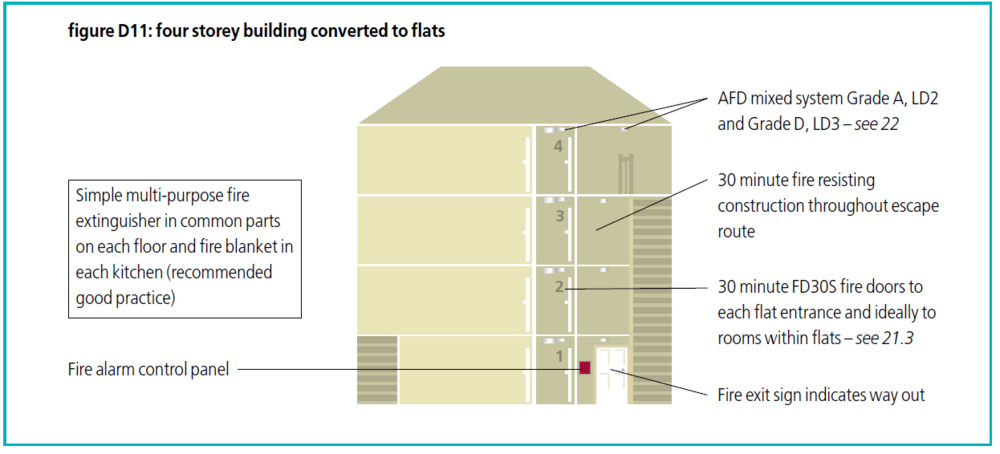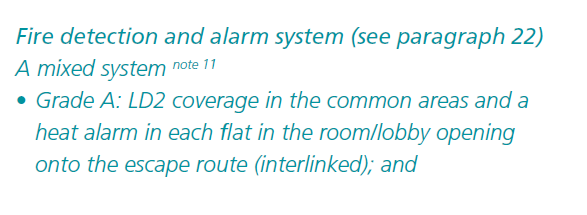-
Posts
2,721 -
Joined
-
Last visited
Everything posted by AnthonyB
-

How can you stop children from a childcare centre leaving through a fire exit?
AnthonyB replied to a topic in Fire Exits
Locking isn't usually OK if it requires reliance on a code or key. Kitchens are dangerous environments for children and I'd be more worried that they got in the kitchen and that door should be the first point of concern - child gates, access control, etc -

Fire Alarm System for 3 storey owner owned flats.
AnthonyB replied to Rod's topic in Fire Alarm Systems
The premises require a Fire Risk Assessment which should answer this - a key factor is the fire compartmentation or otherwise which will have a big impact on what, if anything, is required -
https://www.asfptraining.org.uk/
-
No, there is no requirement for any interaction, the commercial system can be self contained.
-

Building regulations - unvented pressurised water cylinder
AnthonyB replied to Jon71's topic in Fire Risk Assessments
If you think it complies there is always this option: https://www.gov.uk/guidance/building-regulations-determinations -
Unless you are in Scotland it's at their own risk really - you can't enforce it, only any provision required for the common good, hence why they have the common detector & sounder in the hallway but not a domestic one. If they asked for a Home Fire Safety visit by the fire service they would potentially get a Grade F1 smoke alarm fitted free if it's a cost thing, but otherwise if they want to risk their lives that's their choice as the required provisions to protect others are in place. Read your lease though - it might have something out of the ordinary that you could use.
-
You need a fire risk assessment by a competent person to decide this (by law you should have one already anyway!). The front doors are a problem (heritage doors can be upgraded to suit listed status, but just because the Building is listed doesn't mean all interior elements are - check the listing). You might need an alarm (especially with the current doors), but then again you may be able to avoid this. The nature of the fire separation between ground and first floor would be a factor too. I'd need to see it really - you might not need much but equally you might need loads too!
-
Not generally if the protected hallway isn't compromised as you say and no third room exits via the lounge/kitchen
-
Bathrooms don't need fire doors, it's clear in Building Regulations. The kitchen would, you will struggle to find a compliant sliding door solution though. https://assets.publishing.service.gov.uk/government/uploads/system/uploads/attachment_data/file/937931/ADB_Vol1_Dwellings_2019_edition_inc_2020_amendments.pdf
-

Flat fire door for private entrance
AnthonyB replied to Nibarb's topic in Fire Doors and Accessories
Yes, as this was a requirement before Grenfell. The block owner now has absolute not implied legal responsibility for assessing the suitability of flat front doors and where they don't meet government guidance can be considered automatically in breach of the legislation when the Fire Safety Act. Rising butt hinges have not been accepted since 2011 in guidance and so it would be correct to replace. I don't know who the Fire Depot are, but as the fire service don't enforce fire safety in flats nor generally have the resources to check individual flats annually through their Community Safety checks (which is done by staff who specialise in domestic fire prevention and not the general block regulations) but just because they don't raise an issue doesn't mean the need to change is wrong. -
What age are these flats? As the actual flat is outside the scope of the Fire Safety Order what is your brief for dealing with the internal layout - is the flat owner wanting them checked as part of a type 3 FRA or for Housing Act compliance?
-
What will it be built from?
-
The official guidance is here: https://www.nationalfirechiefs.org.uk/write/MediaUploads/NFCC Guidance publications/Protection/09062018_NFCC_Mobility_Scooter_Guidance_Final.pdf A lounge that is a separate sub compartment from the escape routes as you describe is far better than being on the corridors or stairs, but is still not ideal - a purpose built area is always preferred. This may not be practicable of course, which is where true risk assessment comes in - as I haven't been and assessed your premises I can't say for sure it's tolerable or that there is no viable alternative, but it's certainly not the worst location I've seen.
-
Normally a stud wall with 12.5mm plasterboard either side, if correctly built and fitted would achieve 30 minutes. Usually edges needs to be taped and sealed or a plaster skim applied as well
-

Can an openable window be fitted to an internal wall?
AnthonyB replied to CARL S's topic in Fire Prevention
You've answered your own question. You could in theory have a fire resistant fixed window and a separate ventilation grille with a combined fire/smoke damper linked to the fire alarm in the wall, but they wouldn't be up for the cost of all that I suspect... -
Ceiling tiles are easily removable without the need for tools, so shouldn't satisfy the requirement unless the system is more securely fixed - missing tiles are a common site in suspended ceilings.
-
Before 1991 CP3 Chapter IV Part 1 applied - all it says for chutes is: Refuse chutes should conform to CP 306. The enclosing structure should be of non-combustible materials and should have a fire resistance of not less than one hour or that period required by the Building Regulations for the elements of structure of the building, whichever is the greater. Refuse chute access hoppers should not be in any stairway enclosure or corridor, nor in a stairway protection lobby. Refuse chute enclosures should be ventilated to the open air.
-
Cross corridor door/partition at 30m, ladder remains as alternative exit, restricted access to suit 5/10 persons limit on ladders - there is little that can be done that is proportionate to the risk.
-
I've never heard that one before! It's part of the initial planning for horizontal evacuation and has nothing to do with the stairs - windows aren't part of escape route planning so a fire can still block an exit overloading those remaining even at ground level. As you will see from these two different guides discounting applies in all cases: https://www.twfire.gov.uk/wp-content/uploads/2018/11/Occupancy-Figures-Calculation-Guidance.pdf https://www.bedsfire.gov.uk/Business-safety/Premises-fire-safety/Calculating-Occupancy-Capacities-for-buildings-used-for-Assembly.pdf
-
1991 with the first Approved Document B - I'd have to dig out the older rules to check those but I doubt in was in those.
-
Usually they are either 100mmx100mm square or 80mm diameter based on what is sold ex-stock by suppliers and I've never seen smaller. Letter heights on signs used to be set in fire certificates, but now it's usually based on viewing distances and the signage British Standards. If the standard says 70mm considering the 'point blank range' viewing distance the smallest size in guidance would apply - although 80mm is the smallest sign I've ever seen for sale - the ones on sound like specials or made on a label printer.
-
Many modern LED fittings are dual purpose and can be set up for either maintained or non maintained mode and it sounds like the unit is in maintained mode, although if it wasn't lit when you first installed it I can't see how it's changed just sat there!
-
What sort of building is it and where does your room open onto?
-




